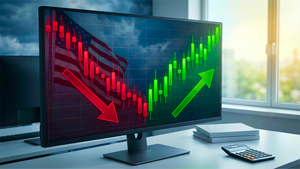Financial News
Stagflation Fears Resurface: Economic Data Signals Market Caution

A troubling confluence of recent economic data points has sent a shiver through financial markets, reigniting fears of "stagflation"—a dreaded economic scenario characterized by stagnant growth, high unemployment, and persistent inflation. The flat reading in the ISM Services index for July, a significantly weaker-than-expected jobs report, and a narrowing U.S. trade deficit, while seemingly disparate, collectively paint a concerning picture of an economy grappling with both slowing momentum and stubborn price pressures. This emerging landscape signals potential economic challenges ahead, prompting market caution and raising questions about the efficacy of current monetary and fiscal policies.
The immediate implication of these indicators is a heightened sense of uncertainty among investors and businesses. A slowdown in the services sector, which forms the bedrock of the U.S. economy, coupled with a deteriorating labor market, suggests that the post-pandemic recovery might be losing steam faster than anticipated. Simultaneously, inflationary pressures, particularly evident in the "prices paid" component of the ISM Services report, indicate that the cost of living and doing business continues to rise, squeezing consumer purchasing power and corporate margins.
Economic Indicators Flash Red: What Happened and Why It Matters
The recent economic releases have provided a stark reality check for an economy that many hoped was on a path to a soft landing. The Institute for Supply Management (ISM) Services Index, a critical barometer for the sector that accounts for nearly 70% of the U.S. economy, registered an unexpected decline to 50.1 in July 2025, barely above the 50-point threshold that separates expansion from contraction. This marginal figure, down from 50.8 in June, suggests a near-stagnation of service-sector activity. More alarmingly, the "prices paid" sub-index within the report surged to 69.9, its highest level since October 2022, indicating intensifying inflationary pressures. The employment component also deteriorated to 46.4, signaling a contraction in services employment for the fourth time in five months.
Adding to the economic unease, the latest U.S. jobs report for July 2025 revealed a significant weakening of the labor market. The economy added a mere 73,000 nonfarm payroll jobs, falling substantially short of economists' expectations. This disappointing figure was compounded by sharp downward revisions to May and June's job gains, collectively amounting to 258,000 fewer jobs than previously reported. May's initial gain of 144,000 was revised to just 19,000, and June's 147,000 was cut to 14,000. The three-month average employment gain has plummeted to a "troublingly low 35,000," and the unemployment rate edged up to 4.2% from 4.1%. This data suggests employers are in a "low-hiring, low-firing limbo," delaying hiring due to economic uncertainty, with manufacturing jobs particularly affected.
Finally, the U.S. trade deficit narrowed to $60.2 billion in June 2025, the lowest since September 2023. While a narrowing deficit might typically be seen as positive, the underlying reasons for this change are concerning. The reduction is largely attributed to President Donald Trump's tariff policies, which have led to declines in both imports and exports. Businesses, having rushed to import products before higher tariffs were applied, are now working through that inventory. Tariffs are increasing input costs for businesses, making planning more difficult, and are cited as a driver of future inflation. This suggests that the narrowing deficit is a symptom of declining trade activity and increased costs, rather than a sign of robust economic health, further contributing to the stagflationary narrative.
The key players involved in this unfolding economic narrative include the Federal Reserve, which faces a renewed dilemma in balancing inflation control with growth support; the U.S. government, whose trade policies are directly impacting economic activity and costs; and, of course, businesses and consumers who are directly experiencing the effects of slowing growth and rising prices. Initial market reactions have been cautious, with equity markets showing volatility and bond yields reflecting a flight to safety, as investors grapple with the implications of a potentially prolonged period of economic malaise.
Navigating the Storm: Potential Winners and Losers
In a stagflationary environment, the landscape for public companies shifts dramatically, creating distinct winners and losers. Companies with strong pricing power and those operating in essential services or defensive sectors tend to fare better, while those reliant on robust consumer spending or facing high input costs are likely to struggle.
Potential Winners:
- Utilities and Consumer Staples: Companies like NextEra Energy (NYSE: NEE) or Procter & Gamble (NYSE: PG) often perform well during economic downturns and inflationary periods. Utilities provide essential services with regulated pricing, offering stable demand. Consumer staples, such as food, beverages, and household goods, are non-discretionary purchases, meaning demand remains relatively inelastic even as prices rise or incomes stagnate. Their ability to pass on increased costs to consumers helps maintain margins.
- Healthcare: The healthcare sector, including pharmaceutical companies like Johnson & Johnson (NYSE: JNJ) and medical device manufacturers, is generally considered defensive. Demand for healthcare services and products remains relatively stable regardless of economic conditions, providing a degree of insulation from economic slowdowns.
- Commodity Producers: Companies involved in the extraction and production of commodities, such as oil and gas (e.g., ExxonMobil (NYSE: XOM)) or precious metals (e.g., Barrick Gold (NYSE: GOLD)), can benefit from inflation, as commodity prices often rise in such environments. However, this is contingent on demand not collapsing due to severe economic contraction.
- Companies with Strong Balance Sheets and Low Debt: Businesses with ample cash reserves and low debt levels are better positioned to weather economic storms, invest opportunistically, and avoid the burden of rising interest rates.
Potential Losers:
- Discretionary Consumer Goods and Services: Companies in sectors like retail (e.g., Target (NYSE: TGT)), automotive (e.g., General Motors (NYSE: GM)), and hospitality (e.g., Marriott International (NASDAQ: MAR)) are highly vulnerable. As real incomes decline due to inflation and job insecurity rises, consumers cut back on non-essential spending, directly impacting these businesses' revenues and profitability.
- Technology Companies (Growth Stocks): High-growth technology companies (e.g., Tesla (NASDAQ: TSLA), Netflix (NASDAQ: NFLX)) often rely on future earnings potential for their valuations. In a stagflationary environment, higher interest rates make future earnings less valuable, and slowing economic growth can dampen innovation and adoption rates, leading to significant valuation contractions.
- Industrials and Manufacturing: While some industrial companies might benefit from infrastructure spending, the broader manufacturing sector, particularly those with complex global supply chains, faces a double whammy of rising input costs (due to inflation and tariffs) and weakening demand. Companies like Caterpillar (NYSE: CAT) could see reduced demand for their equipment if construction and mining activities slow.
- Financials (Banks): While rising interest rates can initially boost bank net interest margins, a prolonged period of stagnant growth and rising unemployment can lead to an increase in loan defaults and a slowdown in lending activity, ultimately hurting profitability for institutions like JPMorgan Chase (NYSE: JPM).
Industry Impact and Broader Implications
The resurfacing of stagflation fears has profound implications across various industries and the broader economic landscape. This event fits into a broader trend of increasing economic volatility and the unwinding of decades of globalization, particularly exacerbated by trade tensions and geopolitical shifts.
Industries heavily reliant on consumer spending, such as retail, hospitality, and entertainment, face significant headwinds. As real wages stagnate and inflation erodes purchasing power, consumers are likely to prioritize essential goods and services, leading to a contraction in discretionary spending. This could force businesses to cut costs, including labor, further exacerbating unemployment. The ripple effect extends to their suppliers, logistics partners, and even commercial real estate, as demand for retail and office spaces may decline.
The manufacturing sector, already grappling with supply chain disruptions and increased input costs due to tariffs, faces a compounded challenge. Companies that have offshored production to leverage lower labor costs are now confronting the dual threat of rising transportation expenses and trade barriers. This could accelerate the trend towards reshoring or nearshoring, albeit at a higher cost, potentially leading to higher domestic prices for goods. Industries like automotive and electronics, with their intricate global supply chains, are particularly vulnerable to these shifts.
From a regulatory and policy standpoint, the re-emergence of stagflation presents a formidable challenge for central banks and governments. Traditional monetary policy tools, such as interest rate adjustments, are less effective in a stagflationary environment. Raising rates to combat inflation risks stifling already weak growth and increasing unemployment, while lowering rates to stimulate growth could fuel inflation further. This "policy dilemma" could lead to unconventional measures or a prolonged period of economic stagnation as policymakers struggle to find a balance. Fiscal policy, too, faces constraints, with governments potentially hesitant to implement large stimulus packages that could exacerbate inflation or debt levels.
Historically, the 1970s serve as a stark precedent for stagflation. Triggered by oil shocks and expansionary monetary policies, that decade saw persistent high inflation alongside economic stagnation. The current situation, while different in its triggers (trade wars, supply chain issues, and post-pandemic fiscal stimulus), shares the core characteristics of slowing growth and persistent inflation. Lessons from the 70s suggest that breaking the cycle requires decisive, often painful, policy actions, and can lead to a prolonged period of economic adjustment. The current environment also highlights the fragility of global supply chains and the potential for geopolitical tensions to directly impact domestic economic stability.
What Comes Next
The path forward for the U.S. economy, under the shadow of resurfacing stagflation fears, is fraught with uncertainty, demanding careful navigation from policymakers, businesses, and investors alike. In the short term, markets are likely to remain volatile as investors digest incoming economic data and assess the Federal Reserve's response. We could see continued shifts from growth-oriented stocks to value and defensive sectors, as capital seeks safer havens. Businesses will likely prioritize cost control, inventory management, and supply chain resilience, potentially leading to further hiring freezes or even layoffs in vulnerable sectors.
In the long term, the economy faces several potential scenarios. One possibility is a prolonged period of "muddle-through" stagflation, where growth remains sluggish, unemployment gradually ticks up, and inflation persists at elevated levels, albeit perhaps not spiraling out of control. This scenario would necessitate a fundamental shift in corporate strategies, focusing on efficiency, domestic sourcing, and strong pricing power. Another, more optimistic, scenario involves a "soft landing" where inflation gradually recedes without a severe recession, perhaps aided by a resolution of trade tensions and a normalization of supply chains. However, the recent data makes this outcome appear increasingly challenging. A more pessimistic scenario could see a deeper recession if the Federal Reserve is forced to aggressively hike rates to combat entrenched inflation, leading to a significant contraction in economic activity and a sharp rise in unemployment.
Strategic pivots will be crucial for businesses. Companies may need to re-evaluate their global supply chains, potentially investing in automation or diversifying sourcing to mitigate future disruptions and cost increases. Innovation focused on efficiency and cost reduction will become paramount. For consumers, adapting to higher prices and potentially stagnant wages will require more prudent financial planning and a shift in spending habits.
Market opportunities may emerge in defensive sectors, commodities, and companies with strong pricing power or those that can benefit from increased domestic production. Conversely, challenges will persist for highly cyclical industries, those with high debt loads, and businesses heavily reliant on discretionary consumer spending. Investors should prepare for a period of lower returns and increased risk, emphasizing diversification and a focus on companies with robust fundamentals.
Conclusion
The recent economic data, particularly the flat ISM Services index, the weaker jobs report, and the tariff-influenced narrowing trade deficit, collectively serve as a stark warning that stagflationary pressures are indeed resurfacing in the U.S. economy. This confluence of slowing growth, rising unemployment, and persistent inflation presents a complex and challenging environment for all stakeholders. The services sector, the engine of the U.S. economy, showing signs of stagnation alongside escalating costs and contracting employment, is a particularly concerning development.
The key takeaway from this event is the growing uncertainty surrounding the economic outlook. The traditional tools for managing the economy appear less effective in a stagflationary environment, leaving policymakers with difficult choices. Businesses must adapt to a landscape of higher costs, potentially weaker demand, and increased supply chain volatility. Consumers, meanwhile, face the dual burden of rising prices and a less robust job market.
Moving forward, investors should closely watch several key indicators. The Federal Reserve's monetary policy decisions will be paramount, as will any shifts in government trade policy. Further readings on inflation (CPI, PPI), employment figures, and consumer spending will provide crucial insights into the economy's trajectory. The resilience of corporate earnings in the face of these headwinds will also be a critical factor. This period demands a cautious and adaptive approach, as the economic currents suggest a challenging path ahead, requiring vigilance and strategic foresight from all participants in the financial markets.
More News
View More




Recent Quotes
View MoreQuotes delayed at least 20 minutes.
By accessing this page, you agree to the Privacy Policy and Terms Of Service.



